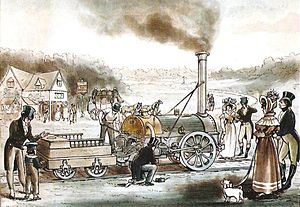Northumbrian
| Northumbrian | |
|---|---|
|
Contemporary representation of the Northumbrian
|
|
| Number: | 4th |
| Manufacturer: | Robert Stephenson & Co. , Newcastle |
| Year of construction (s): | 1830 |
| Type : | A1 n2 |
| Gauge : | Standard gauge (1435 mm) |
| Length: | 7.3 m (with tender) |
| Service mass: | 7.3 t |
| Service mass with tender: | 11.5 t |
| Top speed: | 40 km / h |
| Driving wheel diameter: | 1321 mm |
| Number of cylinders: | 2 |
| Cylinder diameter: | 280 mm |
| Piston stroke: | 406 mm |
| Boiler overpressure: | 3.5 bar |
| Grate area: | 0.75 m² |
Northumbrian was a steam locomotive built by Robert Stephenson for the Liverpool and Manchester Railway in 1830 and was the official inaugural train on the route. The locomotive had some major innovations compared to the Rocket . The steam locomotive boiler was used for the first time in its later design with a smoke chamber and a standing boiler attached to the long boiler . For the first time, the cylinders were arranged almost horizontally. In addition, a tender was built for the locomotive for the first time , a wagon that is specially designed to transport the water and fuel supplies.
In contrast to the Northumbrian, the vertical boiler of the Rocket was separated from the long boiler and the water and steam rooms of the two boilers were only connected with pipes. The Rocket did not yet have an actual tender for the transport of supplies. The task was taken over by a normal freight wagon on which the coke and a barrel of water were carried, although the locomotive sometimes drove without this wagon.
In contrast to the later common steam locomotives, the Northumbrian had cylinders behind the single drive wheel set . The weight distribution of the locomotive was unfavorable because the heavy components such as the cylinder and fire box were located above the wheelset and the driving axle only carried the relatively light front end of the steam boiler. This meant that the locomotive tended to skid when pulled , especially since the force on the coupling caused the front end of the locomotive to lift and thus further relieve the drive axle. Furthermore, the arrangement of the cylinders together with the short wheelbase led to a restless run, as the locomotive moved strongly around the yaw axis and thus lurched. A longer wheelbase was used in later designs, which alleviated this problem.
Individual evidence
- ^ A b Rolf-Fredrik Matthaei: 1829 to 1835: Locomotives, technical progress. (No longer available online.) In: George Stephenson. Archived from the original on July 25, 2015 ; Retrieved March 9, 2013 . Info: The archive link was inserted automatically and has not yet been checked. Please check the original and archive link according to the instructions and then remove this notice.
- ^ Rolf-Fredrik Matthaei: Science Museum - "Rocket" and Rainhill. Retrieved on March 9, 2013 (test drives on Saturday, October 10, 1829).
- ^ Brian Hollingsworth: The Illustrated Directory of Trains of the World . MBI Publishing Company, St. Paul, Minnesota 2000, ISBN 0-7603-0891-8 , pp. 8–11 ( full text in Google Book Search).
